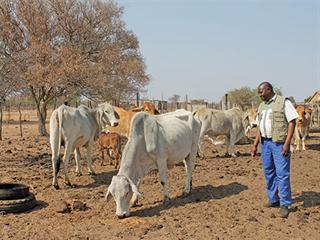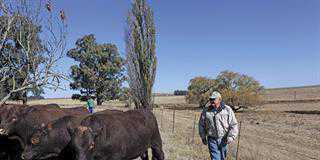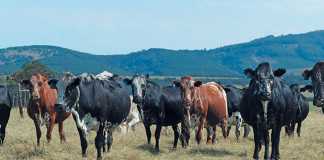
“When I was growing up, I saw how cattle contributed to our upbringing, especially to our education,” says Alfred Maabelo of Ga-Habedi village near Borakalalo National Game Reserve in the North West. Alfred inherited five mixed-breed cattle when his parents shared their cattle between him and his siblings. “I knew then that I wanted to participate in the red meat industry and not just be a subsistent farmer,” he recalls.
In 2004, Alfred was granted a Land Bank loan of R25 000. He used the money to buy 10 white Brahman cows from Paul van Vuuren, a Brahman breeder near Bela-Bela in Limpopo. “Cattle were cheaper then and I paid about R2 500 for each cow,” he remembers. Almost 10 years later, Alfred runs a herd of about 40 cows on communal land in Ga-Habedi. He says that he could have more, but keeps the numbers down because of the challenges he faces farming on communal land. Overgrazing is common as grazing on communal land is not controlled.
“If you don’t limit the animal numbers, supplementary winter feed bills are high,” he explains. According to Alfred, communal livestock farmers chase numbers, sacrificing animal productivity and efficiency. Some farmers have fairly big herds of poor quality animals. “What’s the point of having a bunch of useless animals?” he asks. Some of these, according to Alfred, are too inbred to grow normally. “They’re like thieves because they chew money out of your pocket,” he says.
Advantages of the Brahman
Alfred chose the white Brahman as it grows and matures rapidly. Its meat content, too, is high. “And they’re beautiful animals to look at!” he adds. He has also found that they perform particularly well at sales. Last February, he was amazed to see four of his animals fetching record prices at an auction. “One of my heifers sold for R11 000,” he recalls.
When the dry season arrives, Alfred does not have to be too concerned, as the Brahman copes well on drier veld. “They can adjust to hostile environmental changes,” he says. The cattle are finished on veld and marketed at auctions. Albert takes his animals to the Bela-Bela and Onderstepoort sales. “The problem with the informal market is that you sell one animal at a time, so you get only a small amount of money at a time,” he says.
Supplementary feeding
Because of the low rainfall, supplementary feeding is necessary, especially in winter. Brahman are naturally good foragers, and can stay on the veld for longer. “I stretch out the grazing as much as possible and start supplementing later in winter,” explains Alfred. Animals are fed supplements to prevent weight loss and increase productivity. Supplementary feeding helps animals to recover before the first rains. Cows are kept away from the bull during winter and start grazing in spring when the grass begins to flush.
In winter, the veld is dry and low in protein. The grass is not easy to digest and the cattle eat less. “I supplement with feed mixtures containing P12, which helps with protein, Kalori 3000, which increases palatability and has a good energy content, and salt,” he says.
Parasite control
Ticks are rife in this area and in summer Alfred dips to control ectoparasites. He says that Brahman have some natural tick resistance, but due to the high infestation of ticks, he has to dip. So far he has not lost any of his animals to tick-borne diseases. Heartwater is the only problematic disease in the area, and there are no poisonous plants, unlike the northern section of the Borakalalo Game Reserve.
Management
Alfred has struggled to keep his breed pure as his herd shares the land with several other herds. Some farmers do not manage their cattle properly and let bulls graze freely with cows. “You cannot tell your cattle which bulls to mate with,” says Alfred. Farmers develop their own management systems. Alfred’s is to have a full-time herdsman who keeps the cattle separated. The herdsman makes sure he doesn’t let the cattle out of his sight.
“One mistake can cost you dearly,” stresses Alfred. He says that when farming on communal land, choosing a herdsman is very important. “You cannot just pick up anyone from the street,” he stresses. “You need someone who knows cattle well and who will pay close attention to the animals.” As there is no specific breeding season, every cow in the kraal is monitored.
“This is to make sure we pick up signs that they’re on heat so we can put them to the bull,” says Alfred. Symptoms are restlessness and ‘bulling’ behaviour – the cows mount each other. “Cows come on heat at least every 21 days and the heat lasts anything between six and 18 hours,” Alfred explains. He has a calving rate of more than 90% and a weaning rate of 98%. The calves are weaned at seven months, depending on their condition. Weaker calves are left to continue suckling while stronger calves in good condition are weaned using nose rings.
Because of the communal land constraints, calves cannot be separated from their mothers into weaning camps but remain with them. “This does minimise the stress caused by weaning,” admits Alfred. During the dry winter, the cattle are not in good condition, so no breeding takes place. He uses one bull for the herd and replaces it every three to four years. This is to avoid the problem of inbreeding. The bull is kept at Alfred’s yard, which ensures that he does not mix with other cattle from the village.
“Some people just rear animals and do not take good care of them,” says Alfred. “They don’t deworm, dose or vaccinate the cattle, which might be dangerous for other cattle. If you let the bull mix with these cattle, it could be infected with sexually transmitted diseases (STDs) which may lead to reproduction problems in the herd.
Lack of financial assistance
“I continue with my attempts to get my own piece of land,” says Alfred. So far, he has not been successful in getting the assistance necessary to acquire his own farm. He says this is one of his biggest challenges, as being on communal land makes it difficult to expand. Other challenges include poachers who hunt game animals, and a lack of proper fencing.
“These people set wire traps, which snare our cattle.
“We’re on the eastern border of the Borakalalo Game Reserve and there is game here as well,” says Alfred. “We have tried addressing this with the police but in vain. We’ve also made an application through CASP for fencing, but so far nothing has happened.”
Phone Alfred Maabelo on 072 053 1778.













